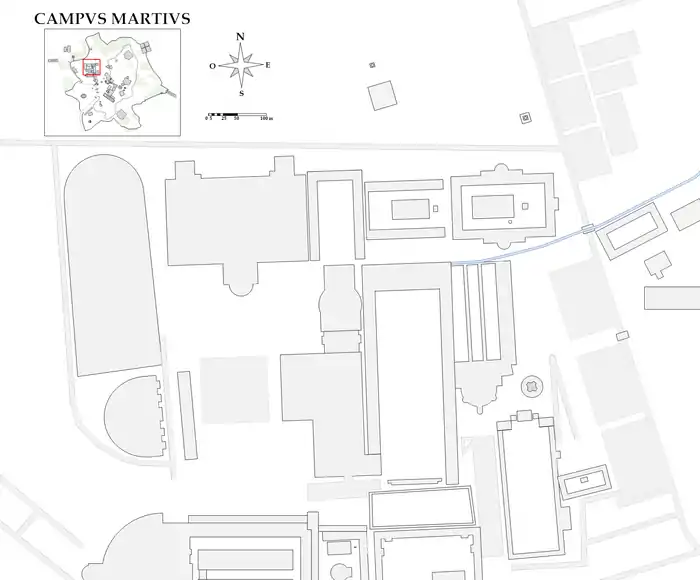Porticus Vipsania
The Porticus Vipsania was a map of the world once displayed in the Campus Agrippae, located in Rome, not far from the Via Flaminia. It was designed by Marcus Vipsanius Agrippa and constructed by his sister Vipsania Polla after Agrippa died.[3][4] The map was named either directly after Vipsania Polla or the gens Vipsania, which Polla and her brother Agrippa belonged to.[5][6]
PORTICVS VIPSANIA | |
 Shown within Italy | |
| Alternative name | portico of Vipsania porticus Pollae[1] porticus Europae[2] |
|---|---|
| Location | Italy |
| Region | Metropolitan City of Rome Capital, Lazio |
| Type | portico |
History
Augustus had a world map engraved on marble, following the descriptions given in Agrippa's geographical work, the Commentarii.[7] Agrippa began construction of the map before his death in 12 BC, after which his sister Vipsania Polla oversaw the project.[8] It was not yet completed by 7 BC when Augustus opened the Campus Agrippae to the public. Polla had likely died before this[9] as Augustus was the one who finished the project at a later date.[10] It was the relatives of a person who were responsible for completing tasks begun by a person, once his sister died Augustus who was Agrippas father-in-law likely felt responsible for it. It was considered inappropriate to interfere with another family's works so Augustus included a description by the portico which explained the process of its making.[5] Although the Porticus Vipsania has not survived, a description of it is given in Natural History by Pliny the Elder, and it is also known through the Peutinger Map.
Location
| Plan of the central Campus Martius |
|---|
See also
References
- Martial's Epigrams Book Two. Translated by Williams, Craig A. Oxford University Press. 2004. p. 70. ISBN 9780195348200. Retrieved 2020-05-28.
- Duff, James Duff, ed. (1932). D. Ivnii Ivvenalis Satvrae XIV. Juvenal. University of Michigan: The University Press. p. 223.
- "www.quondam.com/e28/2897.htm". www.quondam.com.
- Rodriguez, Connie (1992). "The Porticus Vipsania and Contemporary Poetry". Latomus. 51 (1): 79–93. JSTOR 41536195.
- Bianchetti, Serena; Cataudella, Michele; Gehrke, Hans-Joachim (2015). Brill's Companion to Ancient Geography: The Inhabited World in Greek and Roman Tradition. Brill's Companions in Classical Studies. BRILL. p. 219. ISBN 9789004284715.
- Reinhold, Meyer (1933). Marcus Agrippa. Studia historica. 16. University of Michigan: Humphrey Press. p. 136.
- "Lacus Curtius Porticus Vipsania (Platner & Ashby, 1929)". penelope.uchicago.edu.
- Swan, Peter Michael (2004). The Augustan Succession: An Historical Commentary on Cassius Dio's Roman History Books 55-56 (9 B.C.-A.D. 14). Oxford University Press. p. 76. ISBN 9780195347142.
- Bianchetti, Serena; Cataudella, Michele; Gehrke, Hans-Joachim (2015). Brill's Companion to Ancient Geography: The Inhabited World in Greek and Roman Tradition. Brill's Companions in Classical Studies. BRILL. p. 221. ISBN 9789004284715.
- Proceedings of the Royal Irish Academy. 63. University of Chicago: Royal Irish Academy. 1963. p. 151.
